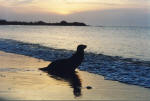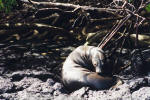The Sea Lions of Galapagos, Ecuador
Sea Lions are any of five species of seals, belonging to the family Otariidae (eared seals), characterized by a coat of short, coarse hair that lacks a distinct undercoat. Sea lions are lithe animals with the small ears typical of the Otariidae; the males, except in the California sea lion, have manes. Like the other otariids, sea lions have longer flippers than do the true, or earless, seals (phocids), and they are able to rotate their hind flippers forward to use all four limbs in moving about on land. Sea lions feed principally on fish and cephalopods (e.g., squid and octopus). Breeding in large herds, the males establish harems of 3 to 20 females. The pups, born after a gestation period of 12 months, are brown. Sea lions are hunted, though not on a large scale, for their meat, hides, and blubber.
The California sea lion, found along the coasts of California, the Galapagos Islands, and Japan, is the trained seal commonly seen in circuses and zoos. A large-eyed, playful animal, it is pale to dark brown but appears black when wet. The male reaches a maximum length and weight of about 2.5 m and 270 kg; the female grows to about 1.8 m and 90 kg. The northern, or Steller, sea lion is a pale- to golden-brown sea lion of the Bering Sea and both sides of the North Pacific. The southern, or South American, sea lion is generally brown with a yellowish belly. Two large brown sea lions are found in the Australasian region: the Australian sea lion and the New Zealand, or Hooker's sea lion. [- Encyclopedia Britannica 2004]
 |
 |
 |
 |
 |
 |
||
 |
 |
||
 |
 |
 |
 |
Designed in collaboration with Vitalect, Inc. All rights reserved. |








